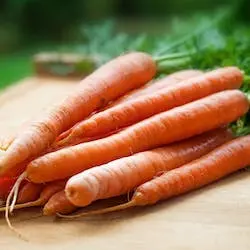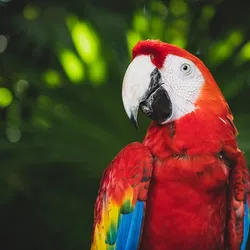
Level 1:
Why are carrots orange? It’s because many years ago, farmers from a place called the Netherlands changed them. They made the carrots orange by choosing the ones that were a bit orange and planting them. This is called breeding. The orange color was a sign that these carrots had lots of something good for your body called beta-carotene.
Level 2:
Have you ever questioned why carrots are bright orange? This common vegetable’s hue did not always look this way. Quite interestingly, it’s the result of centuries of careful farming – a practice known as selective breeding.
Historically, carrots were a medley of colors - purple, yellow, and even white, but not orange. It was farmers in the Netherlands who were responsible for the orange revolution, so to speak. They painstakingly chose the somewhat orange carrots over others and progressively planted those until the vibrant orange we know today dominated. The change was not just cosmetic; these orange carrots were laden with beta-carotene, a nutrient necessary for good health.
Full Story:
When rummaging through your veggies, have you ever pulled up short at the sight of an orange carrot and wondered why it’s its distinct color? Well, the tale of the carrot’s journey to orange might just tip the scale in favor of the power of agricultural manipulation.
Carrots’ transformation story starts almost a thousand years ago from wild roots that were often purple, yellow, white or something in between. But the vibrant orange color we’re so accustomed to is a relatively modern phenomenon, all thanks to the cunning hand of Dutch farmers.
In the 17th century, the Netherlands went through a period of joyous celebration as the House of Orange-Nassau ascended the throne. In a bid to pay homage to their new royal family, Dutch farmers decided to step up their game and aim for a propagation of carrots that would carry the shade of their monarchs. They started with somewhat golden-yellow carrots–already a deviation from the multicolored norm–and embarked on a path of selective breeding.
This down to the wire practice involved choosing carrots with an orange tinge over and over again, generation after generation, until the desired saturation of orange was achieved. The farmers didn’t just go after color. The selection process favored the carrot’s sweetness, shape, and, most importantly, its content of beta-carotene, a nutrient known for providing health benefits.
So, why are carrots orange? It’s safe to say that it’s not just the work of nature, but also an unexpected historical twist that spiced up the genetic makeup of this root vegetable. This might just put paid to the idea that what’s out there in nature is what has always been.
Yet, it doesn’t end here. Modern cultivation continues to toy with the carrot’s genetic palette, producing a rainbow of alternatives from the traditional orange. So, next time you bite into an orange carrot, remember the centuries of work and dedication that went into giving it its signature hue.
Questions:
Question: What caused carrots to change from their original color to orange?
Answer: Carrots changed to the color orange due to selective breeding practices by Dutch farmers. They chose and planted carrots with an orange tinge over generations until the vibrant orange color we know today was achieved.
Question: What is selective breeding?
Answer: Selective breeding is a method used in agriculture where certain plants with desired traits are chosen for propagation. Over time, these selected characteristics become dominant in future plant generations.
Question: What are the benefits of the orange color in carrots?
Answer: The orange color in carrots is not just aesthetic. It signifies high levels of beta-carotene, a nutrient essential for good health.
Question: Are all carrots orange today?
Answer: While the orange carrot is most common, modern cultivation practices have led to a variety of carrots in different colors – from purple and red to white and yellow.
Fill in the Blanks:
pulled up short, tip the scale, the cunning hand, bid, step up their game, down to the wire, go after, work of nature, spiced up, put paid, bite into
The story that explains how we’ve ________ at orange carrots certainly ________ in favor of our farming ancestors. This agricultural makeover was not just the ________, but also a concentrated ________ by dedicated Dutch farmers who decided to ________ in their cultivation practices.
Their ________ efforts to selectively breed carrots for a more orange hue didn’t just ________ color changes; they amplified the vegetable’s beta-carotene content too. These changes namely ________ the longstanding assumption that nature’s colors are immutable.
So, the next time you ________ a carrot, give a nod to the history and hard work that ________ to the multi-hued roots we find today.
Vocabulary:
Breeding - (noun) the process of mating animals to reproduce offspring with certain characteristics
Pulled up short - (phrase) to stop suddenly
Tip the scale - (idiom) upset the balance of a situation
The cunning hand - (phrase) refers to clever or crafty manipulation
Bid - (verb) an attempt or effort to achieve something
Step up their game - (idiom) begin to perform more effectively
Down to the wire - (idiom) until the last moment or the very end
Go after - (phrasal verb) to try to acquire or achieve something
Work of nature - (phrase) a natural process or event
Spiced up - (phrase) to enhance or add interest to something
Put paid - (idiom) to end or destroy something completely
Bite into - (phrasal verb) to use the teeth to cut into something




